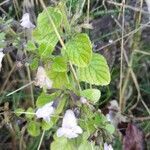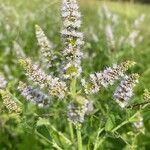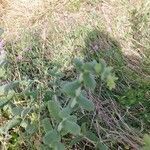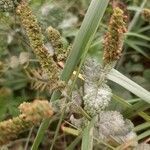Herbs perennial, rhizomatous, stoloniferous. Stems erect, 30-80 cm, striate, crisped villous, pyramidally branched. Leaves usually sessile, circular to oblong-ovate, 2-4.5 × 1.5-3 cm, villous, base cordate, margin crenate or crenate-serrate, apex obtuse. Verticillasters in terminal, dense cylindric spikes 2-4 × ca. 0.6 cm, lower 1 or 2 ± widely spaced; bracts lanceolate, ca. 3 mm, crisped. Pedicel ca. 1 mm, glabrous. Calyx broadly campanulate, ca. 2.5 mm, pubescent, subglobose, dilated in fruit, not constricted at throat, obscurely veined; teeth lanceolate-subulate, ca. 1 mm. Corolla white, purplish, bluish or purple, ca. 2.5 mm, glabrous, tube ca. 1.5 mm; lobes subequal, upper emarginate. Ovary glabrous. Nutlets unknown.
Stout and erect, 4–10 dm, with a sickly-sweet odor; stem sparsely hairy to densely white-tomentose; lvs sessile or nearly so, broad-based and often clasping, obtuse or rounded above, 2–5 × 1–4 cm, 1–2 times as long as wide, crenate-serrate, strongly rugose-reticulate, strongly villous-tomentose beneath, less so above; verticils crowded into elongate terminal spikes (sometimes interrupted below) 3–15 × 0.5–1 cm; cal 1–2 mm, short-hairy throughout; 2n=24. Native of s. Europe, escaped into waste places and along roadsides throughout s. U.S. and n. occasionally to Me. and O.
A herb. It grows 90 cm high and spreads 90 cm wide. It keeps growing from year to year. It has stolons or runners. The stem is erect and 30-80 cm high. There are lines along the stem. The plant is covered with silvery hairs. The leaves usually do not have leaf stalks. The leaves are round and 2-4.5 cm long by 1.5-3 cm wide. There are teeth along the edge. The flower spikes are 2-4 cm long. The flowers are bluish-purple.













